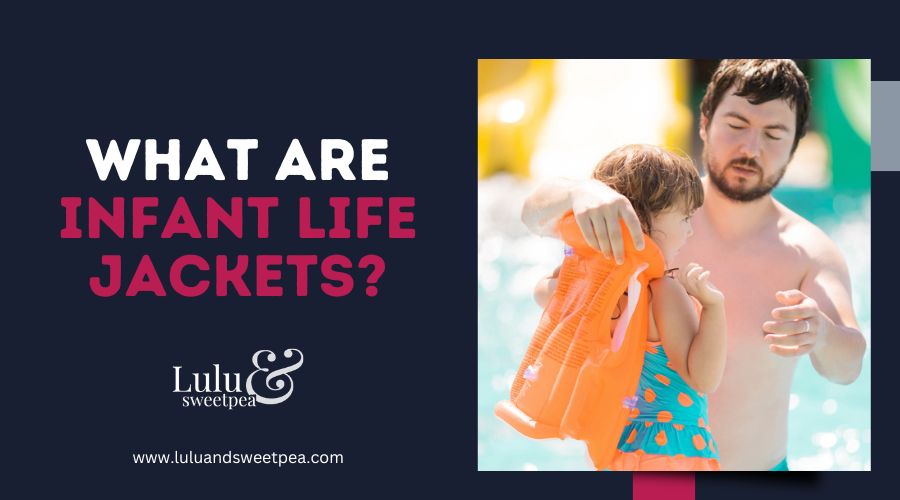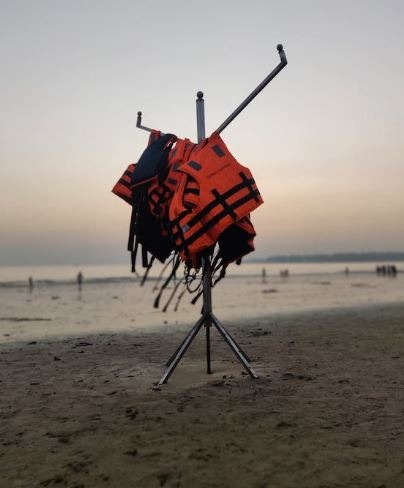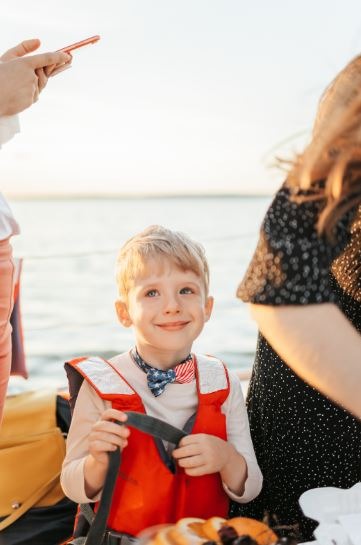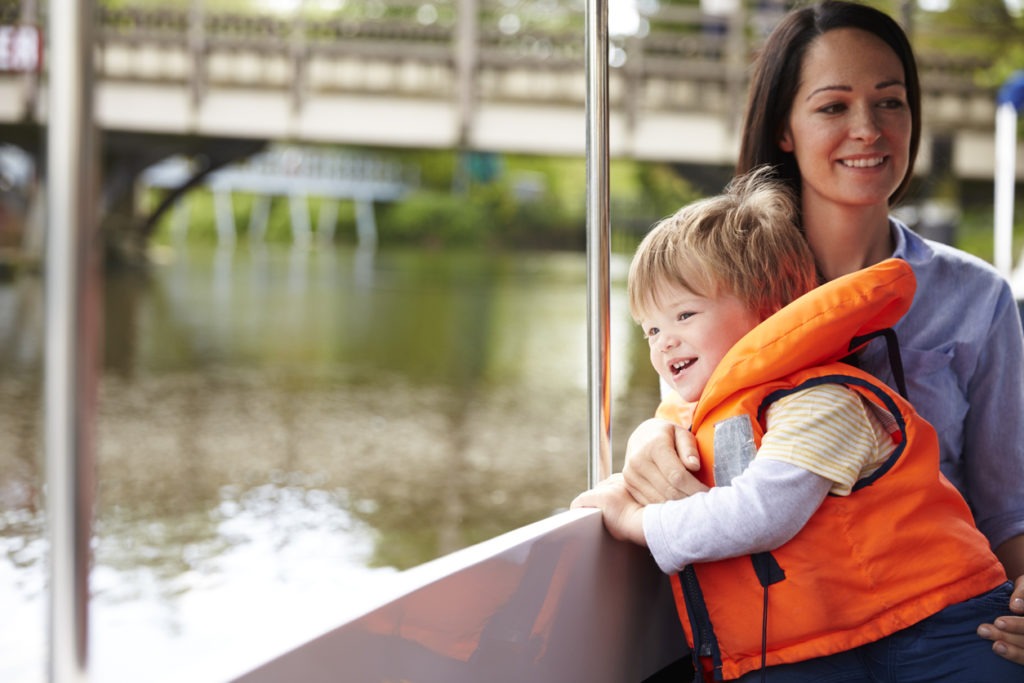The purpose of life jackets is to keep the wearer afloat in water. They will flip you automatically into a face-up posture, keeping your mouth and nose out of the water to prevent drowning. This is especially crucial if you are unconscious when you enter the water.
Children and adolescents should always wear a life jacket when on a boat, raft, inner tube, or in open water such as lakes, rivers, or the ocean. Many individuals who drown accidentally fell into the water. Wearing a life jacket is a straightforward approach to remain safe in and around water.
Note: Always follow manufacturer instructions
What is a life jacket for infants?
A life jacket for infants is a personal flotation device (PFD) that allows your infant to float in the water safely. The proper life jacket features a head support that will turn the infant’s head and face up while floating to prevent drowning.
A USCG-approved seal is the first thing you should check for when purchasing the best newborn life jackets for your child.
This ensures that you may rest easy knowing that the life vest you purchased will keep your child safe in the event of an accident.
Types of Life Jacket
1. Type I Life jacket
This type is ideal for offshore activities in rough, open water that is far from safety and where a swift rescue is improbable. It is built with a headrest that turns the wearer’s face upwards when they are unconscious.
Due to more foam and cloth, this life jacket can maintain heat longer than regular life jackets, but it is also thicker and heavier.
2. Type II Life jacket
This is a lighter and more accessible version of the Type I life jacket. It is intended for usage in inland waterways that are calm and unruffled. This style is sufficiently comfortable for a child to wear, however it is not recommended for use in stormy waters.
Although some type II life vests have a larger collar, the majority do not, therefore it is best to try them on before committing.
3. Type III Life jacket
This type is the lightest of the three, and thus the least secure. The class III life jacket is intended for usage in protected, near-shore inland waters. Additionally, it is not designed to turn an unconscious wearer’s head.
Important points to consider when purchasing a life jacket for your infant
1. Always purchase a new infant life vest
Yes, you can save more money by purchasing a used life jacket. But will it keep your child fully safe? Although these jackets can endure between 5 and 10 years, if they are repaired or altered, their benefits may be nullified.
The same holds true for prolonged exposure to heat or sunlight, which degrades the inside foam and renders the jacket “brittle.”
Always purchase a new life jacket for your infant, especially if you want to participate in an offshore activity.
2. Accepted by the U.S. Coast Guard
If you desire the highest level of protection for the infant, the jacket must be Coast Guard-approved. The US Coast Guard-approved logo on the PFD indicates that it satisfies all USCG safety regulations and is completely secure.
3. Must be properly sized for infants
While it’s generally a good idea to purchase one size larger when purchasing clothing, you should never do so while purchasing a life jacket for a young child. Always ensure that your infant’s PFD is the correct size. Therefore, you must bring your child with you while purchasing a stroller so that you can try it.
You would know that the infant life vest is a great and safe fit if, when pulling baby up while wearing the jacket, the child’s chin and ears do not fall down through the vest.
A USCG-approved newborn life jacket should include leg straps, a grab strap, and enough head and neck support.
4. Conduct the float test
After acquiring a snug-fitting, full-throttle newborn life jacket, conduct a float test for added safety.
You can accomplish this by strapping the life vest to your child and carefully placing him or her face down in the water (without submerging the child’s face). The vest should immediately make the wearer face up. Replace the vest if it fails to do so, as it is harmful for your infant.
5. Equipped with every safety feature
As discussed briefly previously, a quality USCG life vest should include safety elements like a leg strap, a robust nylon shell, and a highly simple grasp strap. Here are some suggestions to assist you.
6. Crotch strap
A traditional life vest for small children must include a crotch strap. Crotch straps prevent the PFD from riding up and allowing the infant to escape, in addition to securing the vest to the baby’s body.
7. Flotation collar
The fact that your infant is wearing a PFD does not guarantee his or her safety. The flotation collar will provide the necessary head support. It is additional head support that keeps the child’s head out of the water and prevents their face from being immersed.
8. Grab handle
Always include a grab hold, also known as a rescue handle, on your baby’s PFD. This will allow you to rapidly and immediately rescue them in the event of an accident by gripping this strap.
Three Tips for Selecting the Correct Baby Life Jacket Size
It is crucial to note that selecting a life jacket for a newborn is never the same as selecting one for an adult. Regarding the infant’s life jacket, a different measurement must be taken into account.
1. Current infant weight
Be sure to weigh your infant before purchasing a life jacket for them, as the appropriate size of a life jacket for a newborn depends on their current weight. You can go to Sizing a Kids Life Jacket for assistance in determining the optimal life jacket for your infant based on their weight.
2. Current infant developmental stage
Has your infant begun to walk? Or, can they walk without assistance? This is essential for the baby’s utmost comfort while wearing their PFD, as life vests for young babies (4 to 12 months) or those who can walk unsupported are built differently to accommodate their mobility and activity.
3. The infant’s favorite color
Babies can be quite particular about their belongings. Thus, it is vital to select a life jacket in a color that your child enjoys, as doing so will encourage them to look forward to and enjoy wearing it, but wearing something that is not their favorite color may drive them to avoid wearing it altogether.
Additionally, their age may also be considered. However, this will be the final consideration when selecting a life jacket for a baby, as their present weight and developmental stage are the most important factors. As the varying sizes of infant life jackets are primarily based on these two factors.
In conclusion
There is no age at which a newborn is too young to wear a life jacket. It can even be worn by an infant. Swimming is a skill that requires a great deal of time and patience to develop, so do not delay in purchasing a life jacket for your infant. Giving your infant early exposure to water may help them become comfortable and confident in the water much earlier and more quickly than is typical.
Lastly, keep in mind that life jackets and life preservers should never replace adult supervision.



